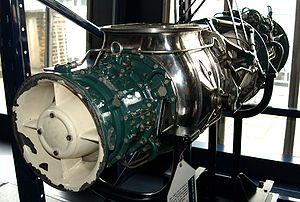- Napier Oryx
-
Oryx Napier Oryx at the Science Museum (London) Type Gas turbine gas generator Manufacturer Napier & Son First run November 1953 Major applications Percival P.74 The Napier Oryx was a British gas-turbine engine designed and built by Napier in the early 1950s. Its sole application was the unsuccessful Percival P.74 tip jet powered helicopter project, like the P.74, the Oryx was cancelled.[1]
Contents
Design and development
The engine was developed by the Aero Gas Turbine Division of Napier in conjunction with Percival, later Hunting Percival. Funding came from the Ministry of Supply.
The P.74 was a design for a tipjet-powered helicopter. The jet power to be supplied from engines within the helicopter and piped to the rotor tips.
The output gas temperature from the engines had to be below 400°C for the helicopter's stainless steel rotor ducts, so a bypass design was used. This also blew "cold" air from the compressor, rather than purely hot turbine exhaust. Rather than using an over-sized compressor with a bypass around the turbine (as commonly used in the turbofan engine), the Oryx used an auxiliary compressor in addition. This was mounted behind the turbine, with its gas flow in the opposite direction to the main engine core.[2] The two air streams were deflected through 90° in a collector chamber, then exited vertically upwards. Gas flow through this collector was arranged so that each stream remained separate, the cold air from the auxiliary compressor passing through a bifurcated duct, so as to wrap around the hotter turbine outlet. By this means, the duct was further protected from the hot exhaust. Separator plates inside each duct split the stream into a number of flows and deflected each one separately, thus preserving the flows approximately constant across the whole duct. When the flows finally merged, they were flowing parallel and at approximately the same velocity, thus reducing turbulence and energy loss.
A Corliss non-throttling valve[2][3] could divert individual engine output to the outside of the aircraft through a butterfly valve (closed in flight), permitting full running with the rotor stationary for starting and ground running. In the P.74 the two Oryx engines fed their outputs to a common duct that took the thrust to the rotor head.
Rotax electric starters were used but alternate methods could have been used.
The Oryx was expected to be used for the planned commercial P.105 development of the P.74. In the P.105 the two engines would have been fitted back to front on either side of the rotor mast, feeding their outputs to the rotor hub. It was anticipated that 900 "gas horsepower"[2] could be produced in its developed form.
Engines on display
A preserved Napier Oryx is on display at the Science Museum (London).
Specifications (Oryx N.Or.1)
General characteristics
- Type: Single shaft gas generator
- Length: 83.5 in (2,121 mm)
- Diameter: 19.25 in (489 mm)
- Dry weight: 495 lb (225 kg)
Components
- Compressor: 12-stage axial flow
- Combustors: 5 tubular chambers
- Turbine: 2-stage
- Fuel type: Avtur or wide cut oil
Performance
- Maximum thrust: about 800 gas horsepower
- Overall pressure ratio: 6:1
- Air consumption: 9.9 lb/sec (4.5 kg/sec) plus 5.1 lb/sec (2.3 kg/sec) from auxiliary compressor
- Turbine inlet temperature: 400C output
- Power-to-weight ratio:
See also
- Comparable engines
- Turbomeca Palouste
- Related lists
References
- ^ Gunston, Bill (1989). World Encyclopedia of Aero Engines. Cambridge: Patrick Stephens. pp. 107. ISBN 1-85260-163-9. "The less said about the Oryx the better"
- ^ a b c d "Napier Oryx" (PDF). Flight: 189–193. 5 August 1955. http://www.flightglobal.com/pdfarchive/view/1955/1955%20-%201081.html.
- ^ A typical "butterfly" valve restricts flow somewhat, even when completely open
- ^ "Napier Oryx" (PDF). Flight: 189–193. 5 August 1955. http://www.flightglobal.com/pdfarchive/view/1955/1955%20-%201077.html.
External links
Napier aero engines Piston engines Turboprop / Turboshaft Coupled Naiad · Eland · Gazelle · Naiad
Turbo-compound Gas-generator Oryx
Rocket Lists relating to aviation General Aircraft (manufacturers) · Aircraft engines (manufacturers) · Airlines (defunct) · Airports · Civil authorities · Museums · Registration prefixes · Rotorcraft (manufacturers) · TimelineMilitary Accidents/incidents Records Categories:- Napier aircraft engines
Wikimedia Foundation. 2010.

